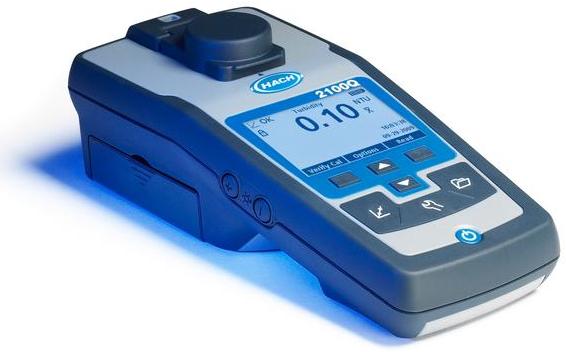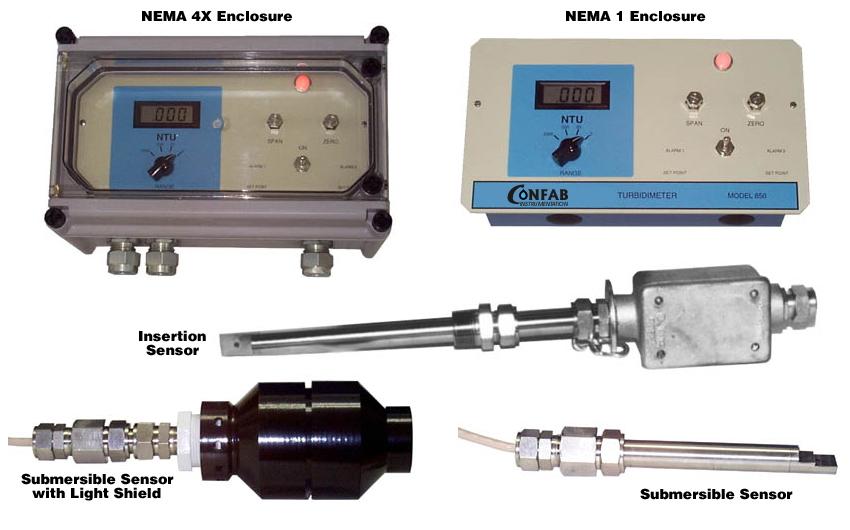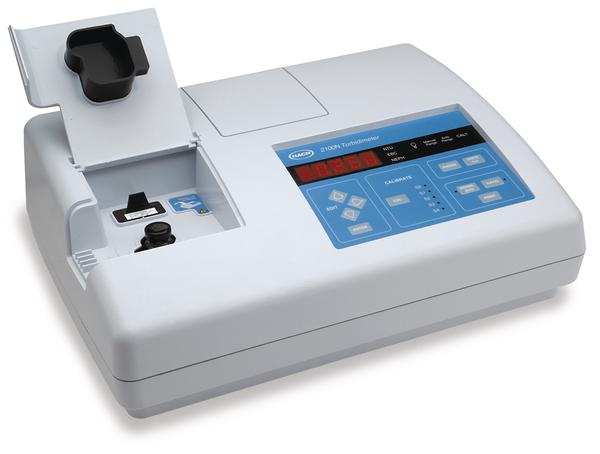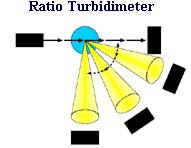Turbidimeters are used to measure the relative clarity of a fluid by measuring the amount of light scattered by particles suspended in a fluid sample. Pictured below are a laboratory and portable turbidimeter.


(Copyright Hach Company, Loveland, CO)
General Information
Suspended solids obstruct the transmittance of light through fluids. The turbidity of a sample may be due to a single chemical substance or a combination of several. A turbidimeter measures this obstruction to determine the haziness, or intensity of light, in a sample, in nephelometric turbidity units (NTU). A cloudy solution has a high haziness value, while a relatively clear solution has a low value.
Note that while tubidimeters measure the effect of particles on the clarity of a fluid, they cannot be used to determine particle size.

The turbidimeter shown above can be used in any size pipe with the insertion-type sensor, but can also be applied to open channel applications with a submersible sensor.
Equipment Design
As seen in the animation, a turbidimeter is composed of a light source, a focusing lens to direct a beam of light through a sample, a photoelectric detector positioned at a 90° angle from the beam to measure the amount of light scattered, and a light trap, to prevent any light already past the sample from being detected and giving faulty readings.
Turbidimeters send beams of light (yellow lines) into a sample (blue) that contains particles (black dots). The particles absorb this light energy and radiate it in all directions. The manner in which the two interact depend on the size, shape, and composition of the particle, the wavelength of the light beam, and the refractive index of the sample. The refractive index of the particle must be different than the suspending fluid. As this difference increases, the scattering becomes more intense.
Ratio and non-ratio turbidimeters share the same design, as shown in the schematics below. The non-ratio turbidimeter only has one detector at 90° to the beam of light, while the ratio turbidimeter has two additional detectors at alternate angles.
A calibrated slit turbidimeter is based on a visual comparison of the intensity of light scattered by a sample under certain conditions compared to the intensity of light scattered by a reference standard under the same conditions.
Other designs include Hellige turbidimeters, photoelectric nephelometers, and many others. Parr turbidimeters and Jackson candles are seldom used.
Usage Examples
A turbidimeter is used in many process applications in the industrial, municipal, pharmaceutical, and pulp/paper industries. Shown here is a scientist demonstrating the use of a turbidimeter to monitor water quality.

Turbidimeters can be used in the food industry to detect trace contaminants in various fluids. They can monitor the clarity of the mild acids used in the pulp and paper industry, and are used to monitor microbiological cultures in antibiotic production.
Advantages
- Able to interface with other equipment to analyze results.
- One of the easiest and most accurate water analysis techniques.
- Provides industry with final quality check of many fluid-based products.
Disadvantages
- Inconsistent readings among different designs.
- Light in a sample not due to sample scattering can be read by the detector and give faulty readings.
- Air bubbles in the sample reflect light and give erratic signals.
- Cannot measure the size of particles in a sample.
Acknowledgements
- Confab Instrumentation, Jackson, CA
- Hach Company, Loveland, CO
References
- Hart, Vincent S., Chris E. Johnson, and Raymond D. Letterman. “An Analysis of Low-Level Turbidity Measurements.” American Water Works Association Journal 84 (1992): 40-45. Print.
- Jethra, Ravi. “Turbidity Measurement” ISA Transactions: Journal of the Instrument Society of America 32 (1993): 397-405. Print.
- Lex, Donald. “Turbidimeter Technology Turns On The High Beams.” Intech 41 (1994): 36-38. Print.
- Sethi, Virendra, Patnaik Priyamvada, Pratim Biswas, Robert M. Clark, and Eugene W. Rice “Evaluation of Optical Detection Methods for Waterborne Suspensions.” American Water Works Association Journal 89 (1997): 98-112. Print.
Developers
- Jonathan West
- Steve Wesorick
- Kelsey Kaplan



